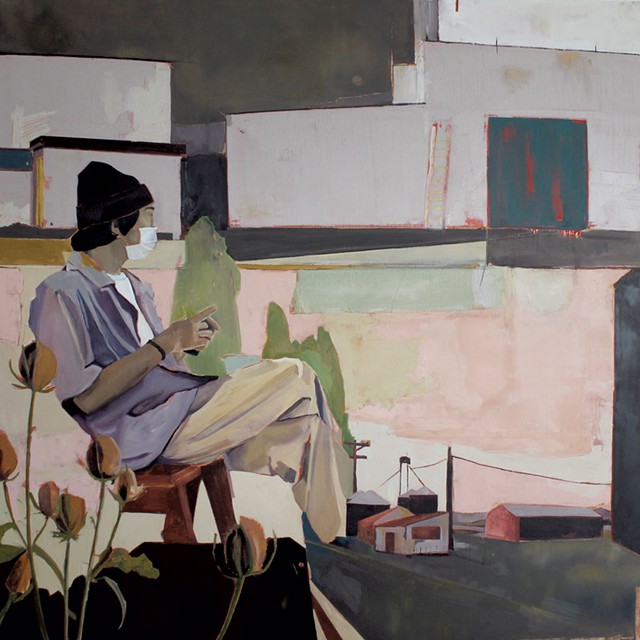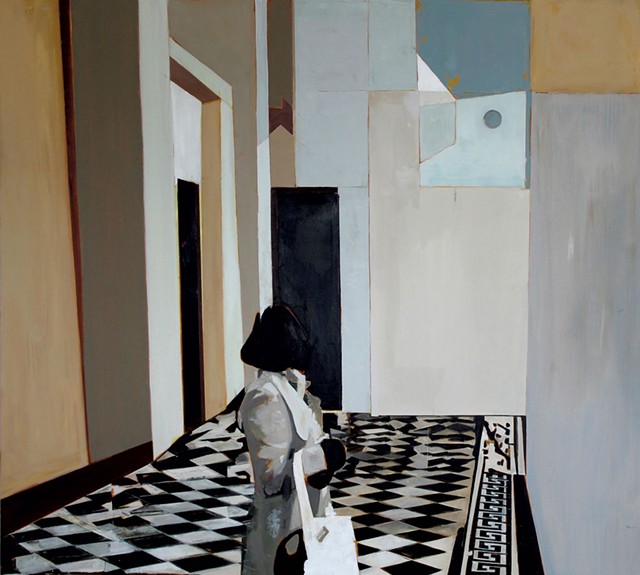
- Courtesy
- "Untitled (or that which we carry)"
Montpelier artist Kate Burnim titled her current exhibit of paintings "Liminal Arc" for good reason: She's fascinated with in-between spaces. And by that she means not just physical space but temporal, psychological and emotional, and even shifts in direction during her artistic process. Physical evidence abounds on each of her canvases, if one knows how to look.
In roughly two dozen enigmatic paintings at the Vermont Supreme Court Gallery in Montpelier, Burnim presents a multitude of questions and challenges.
She likes to leave clues for the viewer — "the visual record of these investigations, the decisions made, reconsidered, and the new decisions made along the way," as Burnim puts it on her website. This can result in coexisting images or picture planes on the same canvas — read: parallel realities — and the inclusion of geometric forms with no clear purpose. The latter might be seen as expressions of mental states or social circumstances rather than functional objects.
The 36-inch-square painting "Untitled (or that which we carry)" exhibits all these qualities. A relatively large figure is painted in the foreground: a young, dark-haired man dressed in a loose blue shirt, tan slacks and a black beanie. He's also wearing a white mask, his face turned away from the viewer. He appears to be holding a cellphone but isn't looking at it.
What's most intriguing about the figure, however, is that he has no feet. Burnim left his body, and the red chair he's sitting on, unfinished. Instead, the man's crossed legs dangle into a distant farmscape surrounded by a pink sky. This rural vista, too, is cleaved even as it shares common ground. The second reality shift: a cluster of white, wall-like rectangles poking up in the top half of the painting.
"Painting a figure definitely introduces a narrative," Burnim said. But in this case the story is elusive. She said the painting came about from collaging diverse elements together, "but there's some connection to them," she suggested.

- Courtesy
- "Structural Misgivings"
The almost comically named "Structural Misgivings," a 45-by-50-inch oil on panel, encloses a female figure in a baffling — if not nightmarish — space surrounded by myriad tall walls. None has a door. The claustrophobic image allows one portal of blue, presumably sky, at the top, but the black-and-white diamond-patterned floor seems to be buckling, as if from an earthquake. The woman, clad in a tan coat and black gloves and carrying a large white bag, is turned away from the viewer. Without access to her expression, we are left to guess her response to this ominous space.
In other figurative works, Burnim presents subjects with direct gazes and self-assured stances, even in non-realist settings. "Repair," one of the largest works in the exhibit at 48 by 79 inches, is dominated by the figure of a black-clad girl with long blond hair and an attitude that seems to say, "And so?" A stick-figure girl is sketched in at the rear, while inexplicable rectangular shapes border the right side of the painting. The ground, a vast field of white, is hemmed in by a distant wall.

- Courtesy
- "Repair"
"Repair" is one of the paintings that, according to Burnim, speak to the questions of youth and the world they are inheriting. "What are we leaving them?" she asked rhetorically. The young people she depicts are in a liminal space themselves — between childhood and adulthood.
Burnim excels at conveying a sense of loneliness and impermanence even in unpeopled works. The exhibit includes her semiabstracted landscapes set in the Burlington rail yards, in blocky architecture and in scenes glimpsed from a moving train. "By the Lake," 32 inches square, presents recognizable shapes of a warehouse, silo and streetlights but is otherwise rendered in abstract gestures of color. Burnim pairs the real and the intuited with seemingly effortless fluidity.
Though she is deeply engrossed in the formal aspects of painting — palette, composition, mark making, adding and removing paint — Burnim seems equally focused on the storytelling potential of her works. The commonality of her paintings here — liminal space — invites viewers to envision their own.
"There's a part of painting that is always a mystery," Burnim said. "Sometimes I need to just get out of the way."










Comments
Comments are closed.
From 2014-2020, Seven Days allowed readers to comment on all stories posted on our website. While we've appreciated the suggestions and insights, right now Seven Days is prioritizing our core mission — producing high-quality, responsible local journalism — over moderating online debates between readers.
To criticize, correct or praise our reporting, please send us a letter to the editor or send us a tip. We’ll check it out and report the results.
Online comments may return when we have better tech tools for managing them. Thanks for reading.